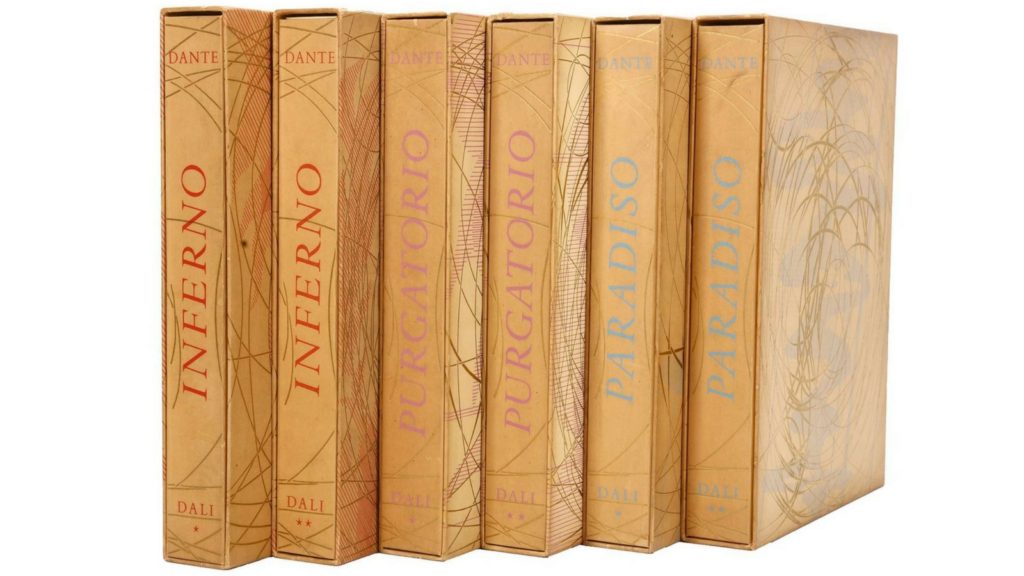Revisiting the Classics: Dalí Interprets Dante’s Visionary Journey
29/08/2017 Chiswick Curates, Books
"This divine work is not plastic, not picturesque, not musical, but all these at once and in accordant harmony. It is not dramatic, not epic, not lyric, but a peculiar, unique and unexampled mingling of all these." F.W.J. Schelling, 1802-03.
 DALÍ, Salvador (1904-1989). Dante, ALIGHIERI (1265-1321). La Divina Commedia. Illustrazioni di Dalí.
DALÍ, Salvador (1904-1989). Dante, ALIGHIERI (1265-1321). La Divina Commedia. Illustrazioni di Dalí.
The Divine Comedy by Dante Alighieri remains one of the most influential works in Western literature. A vivid journey through Inferno, Purgatory and Paradise, it has inspired artists for centuries, but few interpretations are as arresting as Salvador Dalí’s.
In the mid-20th century, Dalí produced 100 illustrations for an edition of La Divina Commedia, offering a surrealist lens through which to view Dante's poetic universe. These artworks fuse psychological symbolism with mythological drama, reflecting both Dalí’s visual language and Dante’s narrative power.
Dante Meets Dalí
Originally commissioned in 1957 by the Italian government to commemorate the 700th anniversary of Dante’s birth, the project was controversial from the start. When Dalí's first illustrations were shown in Rome, public reaction was unfavourable. Many objected to a Spanish artist being chosen to honour a cornerstone of Italian cultural heritage. The commission was withdrawn, but Dalí continued with the project regardless.
Dalí’s illustrations were later carved into 3,500 wood blocks by engravers Raymond Jacquet and Mr. Taricco, under the supervision of Dalí and Jean Estrade of Les Heures Claires in Paris. The resulting woodcuts were published in a limited edition, with each volume containing exquisite colour prints on Rives paper.
A Surrealist Interpretation of a Timeless Text
Dalí’s interpretation brings Dante's world into dialogue with surrealism, Freud, and the subconscious. Familiar Dalí motifs — elongated figures, melting faces, and dream-like transformations — appear throughout, reimagining the medieval themes of sin, redemption and spiritual transcendence.
In Inferno, we encounter grotesque figures such as Minos, the judge of the underworld, and Cerberus, the three-throated hound.
In Purgatory, The Fallen Angel features drawers in the body — a clear nod to Dalí’s 1936 sculpture Venus de Milo with Drawers.
In Paradise, the style softens to depict ethereal beings such as The Angels and The Encounter of Dante and Beatrice, rendered with delicate, celestial grace.
The Divine Comedy in Art History
Over the centuries, Dante’s masterpiece has inspired artists from Botticelli and Gustave Doré to William Blake and Renato Guttuso. Yet Dalí’s vision stands apart for its psychological complexity and modern perspective. He transforms an epic of moral philosophy into an introspective dreamscape.
Despite its controversial beginnings, Dalí’s Divine Comedy has become one of the most celebrated artistic interpretations of Dante’s journey. It stands as a remarkable meeting of two brilliant and imaginative minds, separated by centuries but united in their ability to shape how we see the world.
If you own rare illustrated books, limited edition prints or works on paper, contact our Books and Works on paper department for a free and confidential valuation, or simply fill out our Online Valuation Form